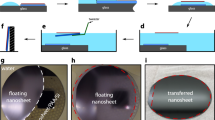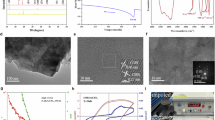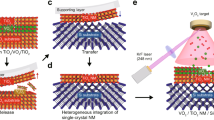Abstract
Single-crystalline thin films of complex oxides show a rich variety of functional properties such as ferroelectricity, piezoelectricity, ferro and antiferromagnetism and so on that have the potential for completely new electronic applications. Direct synthesis of such oxides on silicon remains challenging because of the fundamental crystal chemistry and mechanical incompatibility of dissimilar interfaces. Here we report integration of thin (down to one unit cell) single crystalline, complex oxide films onto silicon substrates, by epitaxial transfer at room temperature. In a field-effect transistor using a transferred lead zirconate titanate layer as the gate insulator, we demonstrate direct reversible control of the semiconductor channel charge with polarization state. These results represent the realization of long pursued but yet to be demonstrated single-crystal functional oxides on-demand on silicon.
Similar content being viewed by others
Introduction
A significant number of single-crystalline complex oxides show ferroic order and a variety of correlated phenomena1,2. Consequently, extensive research effort is currently ongoing in the investigation of these materials both for fundamental science and potential applications. For many of the novel functionalities, it is important to retain the single-crystal nature of these oxides when they are finally interfaced with Si electronics. In addition, it has been long postulated that integration of single-crystal functional oxides with silicon could resolve some of the most critical problems in existing applications such as the memory retention time in ferroelectric random access memory3. As a consequence, there is currently a significant effort to integrate functional complex oxides on silicon4,5,6,7,8,9,10,11,12,13,14,15,16,17. However, owing to large difference in interfacial chemistry and the typically high temperatures and oxidizing environments needed for the growth of such oxides, direct epitaxial synthesis on Si continues to pose a significant synthesis challenge6,7,8,9,10. Such integration is mostly achieved by growing an appropriate buffer layer9,11,12,13,14,15,16, which then acts as a template for synthesis of subsequent layers either by epitaxy or other techniques. Synthesis of a ferroelectric without a buffer layer has also been demonstrated17. However, a common problem in all these methods comes from the electronic incompatibility of the interfaces that leads to dangling bonds and trap states. These trap states in turn dominates the electronic behaviour and decouples the functional oxides from the underlying Si channel. For example, despite the pioneering work of epitaxial growth of a ferroelectric layer on silicon without a buffer layer in ref. 17, a direct and reversible control of the Si channel charge could not be achieved.
In the following, we present a fundamental advancement in the integration of such dissimilar materials. This is achieved by epitaxial transfer of single-crystalline functional oxides directly onto Si. Because of the fact that the process can be carried out at room temperature, it avoids the interface chemistry and thermal issues described above. We demonstrate transfer of functional oxides as thin as one unit cell (4 Å), which is almost three orders of magnitude thinner than any other transfer technique reported for complex oxides. The lattice structure, surface morphology, piezoelectric coefficient, dielectric constant, polarization switching and spontaneous and remnant polarization of the transferred ferroelectric oxide are commensurate with those of the as-grown films on lattice matched oxide substrates. Remarkably, when a transferred Pb(Zr0.2Ti0.8)O3 (PZT) is used as the gate of a silicon-on-insulator (SOI) transistor, it shows clear control of the channel charge with ferroelectric polarization evidenced in the signature anti-clockwise hysteresis loop and an abrupt jump in the current, attesting to high-quality interface and single-crystalline nature of the transferred film respectively. We also demonstrate transfer of single-crystalline superlattices and multiferroic heterostructures on Si that illustrate the tremendous flexibility offered by the technique reported in this work.
Results
Structural characteristics of complex oxides on silicon
For epitaxial transfer, we start by growing single crystal, 0.4–100-nm thick PZT on 20 nm thick La0.7Sr0.3MnO3 (LSMO) coated SrTiO3 (STO) substrate by using pulsed laser deposition (PLD) (for structural properties see Supplementary Figs 1 and 2). Subsequently, the LSMO layer is wet etched. This releases the layer(s) sitting above it (Fig. 1a), which is then carried by a transfer stamp based on polymethyl methacrylate (PMMA) and placed on the target substrate such as Si. High-resolution transmission electron microscopy reveals atomically sharp interfaces and no interfacial layer when Si surface is properly passivated (Fig. 1b, Supplementary Fig. 3a,b). Similar results are obtained when stack with multiferroic (SrRuO3/BiFeO3/CoFeB/MgO) and superlattices (CaTiO3/SrTiO3)6 are transferred (Fig. 1c,d). Figure 2 shows the structural characteristics of transferred films of PZT on Si. The root mean square (RMS) roughness of the transferred PZT is 0.61 nm (Fig. 2a) which is comparable to that of the as-grown film (0.42 nm; Supplementary Fig. 1a). The bottom surface of the PZT, which was released from LSMO, shows a RMS roughness of 0.67 nm (Fig. 2b). This indicates that the surface morphology of PZT is insensitive to the etch chemistry and removal of LSMO. The θ-2θ scan of the transferred film using X-ray diffraction (Fig. 2d) is essentially identical to the as-grown film (Fig. 2c) and shows peaks only from the PZT (001) and Si (00 l) family planes, suggesting that the transferred PZT is a single crystal. The lattice constants for the as-grown and the transferred PZT are 4.14 and 4.15 Å respectively and the full width half maxima measured from the rocking curves are 0.54° and 0.53°. This suggests that the overall film quality remains intact after the transfer process. Similar behaviour is observed when PZT is transferred on other surfaces such as 5-nm amorphous Al2O3 coated Si, thermally grown amorphous SiO2 coated Si, sputter deposited amorphous Au coated Si, single-crystal oxide substrates such as LSMO on STO and so on (Supplementary Figs 3 and 4).
(a) Transfer process. Epitaxial thin films (one unit cell −100 nm) of ferroelectric oxides are grown on lattice-matched substrates with a thin (10–20 nm) sacrificial layer using pulsed laser deposition method. The stack is then immersed in a diluted KI+HCl solution, which isotropically etches La0.7Sr0.3MnO3. A polymethyl methacrylate handle is used to transfer the released ferroelectric layers onto Si and other substrates. Transmission electron microscopy images of the transferred (b) Pb(Zr0.2Ti0.8)O3, (c) (CaTiO3/SrTiO3)6 superlattices and (d) SrRuO3/BiFeO3/CoFeB/Pt multilayers on Si substrate. The scale bars are 5 nm in b,c and 40 nm in d.
(a,b) Atomic force microscopy images of the top and bottom surfaces of transferred PZT. The top surface is probed when PZT is sitting on Si and the bottom surface is probed by placing PZT/PMMA bilayer inverted on Si. The RMS roughness of top and bottom surfaces is 0.61 and 0.67 nm, respectively. These are comparable to 0.41 nm roughness of the source PZT film’s top surface (Supplementary Fig. 1). Scale bar, 1 μm. (c,d) θ-2θ scan and rocking curve around PZT (002) reflection peak of the source PZT on SrTiO3/ La0.7Sr0.3MnO3 substrate and transferred PZT on Si (001). The absence of any phase other than the 001 family of planes of Si and PZT points that the transferred PZT is single crystalline.
Switching in single crystal Pb0.2Zr0.8TiO3 on silicon
Next we studied the electromechanical properties of the transferred PZT using the piezoelectric force microscopy. As shown in Fig. 3a, the ferroelectric domains of the transferred PZT on Si could be reversibly poled by applying oppositely directed electric fields from the piezoelectric force microscopy tip. The domains, thus, obtained retained their respective polarization states even after 24 h. Figure 3b shows the d33-V loop for the transferred PZT on Si. The d33 amplitude is similar to that obtained in the as-grown film (Supplementary Fig. 5).
(a) Piezoforce microscopy of the transferred layer. The ferroelectric domains can be reversibly poled and the states are very stable. (b) The d33 coefficient of the transferred Pb(Zr0.2Ti0.8)O3 on Si. (c,d) P-E and C-E loop of a SrRuO3/ Pb(Zr0.2Ti0.8)O3/SrRuO3 transferred on highly doped Si substrate.
Electronic transport properties of Pb0.2Zr0.8TiO3 on silicon
To understand the quality and applicability of the transferred PZT for electronic applications, we explore the polarization (P)-field (E) and capacitance (C)-E characteristics. Figure 3c,d shows the results for the case where an epitaxial tri-layer SrRuO3(SRO)/PZT/SRO heterostructure on LSMO buffered STO substrate was grown and subsequently transferred onto a Si substrate. The saturation polarization (∼75 μC cm−2) and the peak capacitance (∼1.6 μC cm−2) are similar to a typical as-grown film. The hysteresis is symmetric with the V=0 point because of a symmetric boundary condition on top and bottom for the PZT film18. Importantly, the results in Fig. 3c,d and Supplementary Fig. 6 demonstrate that the transfer method works equally well for multiple layers and therefore any arbitrary heterostructure can be transferred in this way. Monitoring the voltage across the ferroelectric after application of a pulsed voltage shows a transient decrease with time, characteristic of the intrinsic polarization switching19,20,21 (see Supplementary Fig. 7 for details).
Single-crystal Pb0.2Zr0.8TiO3-gated Si transistor
To check the electronic quality of the interface, we demonstrate a functional Si field-effect transistor with a transferred PZT layer as the gate oxide. We exploit one of the major strengths of the transfer process, namely, a single-crystalline ferroelectric can be transferred onto any arbitrary surface, such as Si/SiO2 (3 nm) surface. The Si/SiO2 interface ensures excellent surface for the channel and at the same time provides a large band-offset with the channel that stops hot electrons from easily tunnelling into the ferroelectric atop it. The PZT is then transferred onto the channel to form the gate. Figure 4a shows the normalized, frequency-dependent capacitance of a Si/SiO2 capacitor with and without the transferred PZT on top. The dispersion is identical for both, indicating that the transfer of PZT does not degrade the quality of the interface. The impedance angle is close to 90° for both capacitors over the entire frequency range. Similar behaviour is seen for Si/Al2O3 interfaces (Supplementary Figs 8 and 9). Figure 4b,c show the schematic representation of the fabricated transistor (optical image is shown in Supplementary Fig. 10) and the ID−VG characteristics. There are two important points about the ID−VG characteristic. Firstly, the ID−VG shows counter-clockwise hysteresis for the n-type transistor which is a characteristic signature of the ferroelectric control of the charge. Secondly, the abrupt jump in the current indicates that the ferroelectric PZT switches abruptly as expected in a single-crystalline structure. The handedness of the hysteresis and the abruptness in the current together demonstrate the successful integration of a functional, single-crystalline oxide onto a Si device, a goal that has been long pursued but has so far been elusive17. All of the ID−VG loops are repeatable (Supplementary Figs 11 and 12).
(a) Frequency-dependent capacitance of Si/SiO2 and Si/SiO2/transferred Pb(Zr0.2Ti0.8)O3. The capacitor size is 22 × 22 μm2. (b) Cross-sectional schematic diagram of the fabricated transistor on SOI substrate. The length, L, and width, W, of the silicon channel region are 5 and 10 μm, respectively, whereas gate electrode length is 20 μm. (c) ID−VG (top gate) characteristics of the ferroelectric PZT-gated transistor at VG (back gate)=0. The counter-clockwise hysteresis and two order of abrupt current change in the ID−VG characteristics demonstrates the control of the channel charge by the polarization of the transferred PZT layer.
Discussion
Our work is a fundamental advancement over prior transfer methods that have been explored before for ferroelectrics (such as the smart-cut techniques where only microns thick films have been transferred and a typical surface RMS roughness of 11–70 nm is observed22,23,24,25 due to ion damage. By contrast, we have integrated films with thickness much smaller than this roughness ranges down to a single unit cell. The generality of our approach paves the way to integrate complex oxides on not only Si but also other semiconductors such as GaN where the polarization of a single-crystalline ferroelectric could be used to counteract the built-in polarization. Epitaxially transferred semiconductors is a commercial technology26. This indicates that the reported technique should be scalable to commercially relevant sizes, thereby enabling many novel applications in electronics and multiferroic spintronics26,27,28,29,30,31.
Methods
SOI transistor with FE gate
We start with SOI wafer with a highly doped Si handle, a SiO2 box and a p-type Si with a thickness of∼100 nm as the active region. The Si handle is used as a back gate. First a mesa was defined and the source and drain regions were patterned giving a channel length of 5 μm and width of 10 μm. After that the source and drain regions were doped n+. Next, the Si mesa was covered by a 3 nm thick, thermally grown SiO2 layer. This provides excellent interface with the Si. Then a PZT flake was transferred onto the channel region. Finally the top gate was patterned (see also Supplementary Note 8).
Additional information
How to cite this article: Bakaul, S. R. et al. Single crystal functional oxides on silicon. Nat. Commun. 7:10547 doi: 10.1038/ncomms10547 (2016).
References
Dawber, M., Rabe, K. M. & Scott, J. F. Physics of thin-film ferroelectric oxides. Rev. Mod. Phys. 77, 1083–1130 (2005).
Masatoshi, I., Fujimori, A. & Tokura, Y. Metal-insulator transitions. Rev. Mod. Phys. 70, 1039–1263 (1998).
Ma., T. P. & Han, J. P. Why is nonvolatile ferroelectric memory field-effect transistor still elusive? IEEE Elect. Dev. Lett. 23, 386–388 (2002).
Defaÿ, E. Ferroelectric Dielectrics Integrated on Silicon Wiley (2011).
Shichi, Y. et al. Interaction of PbTiO3 films with Si substrate. Jpn. J. Appl. Phys. 33, 5172–5177 (1994).
McKee, R. A., Walker, F. J. & Chisholm, M. F. Crystalline oxides on silicon: the first five monolayers. Phys. Rev. Lett. 81, 3014 (1998).
Ramesh, R. et al. Ferroelectric La-Sr-Co-O/Pb-Zr-Ti-O/La-Sr-Co-O heterostructures on silicon via template growth. Appl. Phys. Lett. 63, 3592 (1993).
Haeni, J. H. et al. Room-temperature ferroelectricity in strained SrTiO3 . Nature 430, 758–761 (2004).
Baek, S. H. et al. Giant piezoelectricity on Si for hyperactive MEMS. Science 334, 958–961 (2011).
Dubourdieu, C. et al. Switching of ferroelectric polarization in epitaxial BaTiO3 films on silicon without a conducting bottom electrode. Nat. Nanotechnol. 8, 748–754 (2013).
Chin, A., Yang, M. Y., Sun, C. L. & Chen, S. Y. Stack gate PZT/Al2O3 one transistor ferroelectric memory. IEEE Elect. Dev. Lett. 22, 336–338 (2001).
Takasu, H. Ferroelectric memories and their applications. Microelectron. Eng. 59, 237–246 (2001).
Sakai, S. & Takahashi, M. Recent progress of ferroelectric-gate field-effect transistors and applications to nonvolatile logic and FeNAND flash memory. Materials 3, 4950–4964 (2010).
Tokumitsu, E., Okamoto, K. & Ishiwara, H. Low Voltage operation of nonvolatile metal-ferroelectric-metal-insulator-semiconductor (MFMIS)-field-effect-transistors (FETs) using Pt/SrBi2Ta2O9/Pt/SrTa2O6/SiON/Si Structures. Jpn. J. Appl. Phys. 40, 2917–2922 (2001).
Wang, Y. et al. Epitaxial ferroelectric Pb(Zr,Ti)O3 thin films on Si using SrTiO3 template layers. Appl. Phys. Lett. 80, 97 (2002).
Hirai, T., Teramoto, K., Nishi, T., Goto, T. & Tarui, Y. Formation of metal/ ferroelectric/ insulator/ semiconductor structure with a CeO2 buffer layer. Jpn. J. Appl. Phys. 33, 5219–5222 (1994).
Warusawithana, M. P. et al. A ferroelectric oxide made directly on silicon. Science 324, 367–370 (2009).
Eom, C. B. et al. Single-crystal epitaxial thin films of the isotropic metallic oxides Sr1–xCaxRuO3 (0≤ x≤ 1). Science 258, 1766–1769 (1992).
Khan, A. I. et al. Negative capacitance in a ferroelectric capacitor. Nat. Mater. 14, 182–186 (2015).
Salahuddin, S. & Datta, S. Use of negative capacitance to provide voltage amplification for low power nanoscale devices. Nano Lett. 8, 405–410 (2008).
Khan, A. I. et al. Experimental evidence of ferroelectric negative capacitance in nanoscale heterostructures. Appl. Phys. Lett. 99, 113501 (2011).
Levy, M. et al. Fabrication of single-crystal lithium niobate films by crystal ion slicing. Appl. Phys. Lett. 73, 2293 (1998).
Izuhara, T. et al. Single-crystal barium titanate thin films by ion slicing. Appl. Phys. Lett. 82, 616 (2003).
Alexe, M. & Gösele, U. Wafer Bonding Applications and Technology Springer (2004).
Young-Bae, P., Bumki, M., Vahala, K. J. & Atwater, H. A. Integration of single-crystal LiNbO3 thin film on silicon by laser irradiation and ion implantation–induced layer transfer. Adv. Mater. 18, 1533–1536 (2006).
Kayes, B. M. et al. 27.6% Conversion efficiency, a new record for single-junction solar cells under 1 sun illumination. 37th IEEE Photovoltaic Specialists Conference, 4–8 (2011).
Qi, Y. et al. Enhanced piezoelectricity and stretchability in energy harvesting devices fabricated from buckled PZT ribbons. Nano Lett. 11, 1331–1336 (2011).
Zhirnov, V. V. & Cavin, R. K. Negative capacitance to the rescue? Nat. Nanotechnol. 3, 77–78 (2008).
Li, L. et al. Very large capacitance enhancement in a two-dimensional electron system. Science 332, 825–828 (2011).
Heron, J. T. et al. Deterministic switching of ferromagnetism at room temperature using an electric field. Nature 516, 370–373 (2014).
Aguado-Puente, P. et al. Interplay of couplings between antiferrodistortive, ferroelectric, and strain degrees of freedom in monodomain PbTiO3/SrTiO3 superlattices. Phys. Rev. Lett. 107, 217601 (2011).
Acknowledgements
This work was supported in part by the ONR, ARO YIP award, the AFOSR YIP award, the STARNET LEAST Center, the NSF E3S Center and the IRICE Program at Berkeley. We acknowledge discussion with Dr Guneeta Singh Bhalla who first brought our attention to wet etching of manganite films. All additional data are available in the supplementary materials.
Author information
Authors and Affiliations
Contributions
S.R.B. and S.S. designed the experiments. S.R.B. performed epitaxial transfer and electronic transport measurement. S.R.B. and C.W.Y. fabricated the transistor. C.R.S., S.R.B., A.Y., L.D., L.Y., M.L. and J.D.C. deposited the materials. S.R.B., C.R.S., A.I.K. and S.H. measured electromechanical and structural characteristics. S.R.B., S.S. and R.R. wrote the manuscript. All authors helped by providing suggestions.
Corresponding author
Ethics declarations
Competing interests
The authors declare no competing financial interests.
Supplementary information
Supplementary Information
Supplementary Figures 1-12, Supplementary Notes 1-8 and Supplementary References. (PDF 1540 kb)
Rights and permissions
This work is licensed under a Creative Commons Attribution 4.0 International License. The images or other third party material in this article are included in the article’s Creative Commons license, unless indicated otherwise in the credit line; if the material is not included under the Creative Commons license, users will need to obtain permission from the license holder to reproduce the material. To view a copy of this license, visit http://creativecommons.org/licenses/by/4.0/
About this article
Cite this article
Bakaul, S., Serrao, C., Lee, M. et al. Single crystal functional oxides on silicon. Nat Commun 7, 10547 (2016). https://doi.org/10.1038/ncomms10547
Received:
Accepted:
Published:
DOI: https://doi.org/10.1038/ncomms10547







